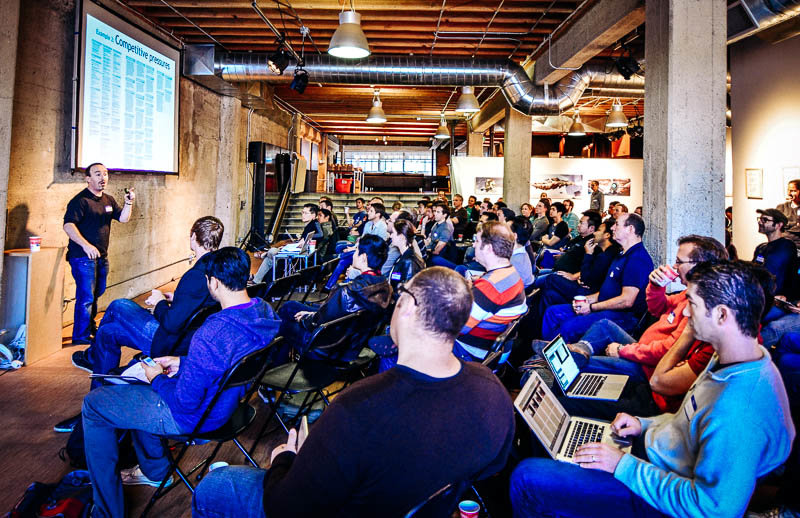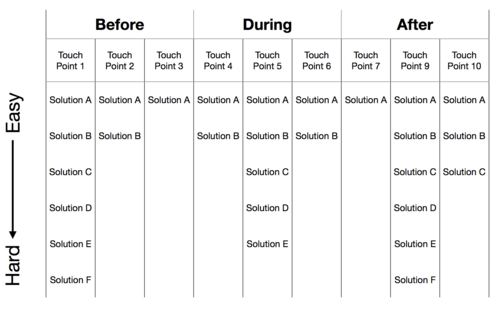NPS is the magic number + 4 other things I learned at Hardware Workshop

 Claus Moberg is the CEO of SnowShoe and has been the driving force behind the company since its inception in 2010 as the winner of a University of Wisconsin-Madison business plan competition. Claus invented the SnowShoe Stamp to address a key bottleneck in the business model, and his proactive leadership has led SnowShoe’s focused pivot into pursuit of the Stamp as a new and exciting authentication technology. Prior to dropping out of his PhD program to focus his energy on the company, Claus was a full-time student at UW-Madison for ten years and earned degrees in Political Science, Economics, Atmospheric Science, and Environmental Studies.
Claus Moberg is the CEO of SnowShoe and has been the driving force behind the company since its inception in 2010 as the winner of a University of Wisconsin-Madison business plan competition. Claus invented the SnowShoe Stamp to address a key bottleneck in the business model, and his proactive leadership has led SnowShoe’s focused pivot into pursuit of the Stamp as a new and exciting authentication technology. Prior to dropping out of his PhD program to focus his energy on the company, Claus was a full-time student at UW-Madison for ten years and earned degrees in Political Science, Economics, Atmospheric Science, and Environmental Studies.
tl/dr: Marc Barros’ Hardware Workshop was awesome. I learned a lot of “stuff” that will be very useful for SnowShoe. If you are thinking about or working on a hardware startup, you should apply for upcoming iterations in NY and Seattle.
I had an awesome experience last week: Marc Barros’ first-ever Hardware Workshop.
Marc was the founder and CEO of Contour Cameras, a wonderful product that competed directly with (and eventually succumbed to the competitive pressures of) the Go-Pro.
Through years of growing Contour into a profitable business, Marc amassed a staggering wealth of both experience and contacts in the hardware startup space. When Marc announced, a few weeks back, that he was going to host a workshop centered around building hardware companies, I quickly and enthusiastically submitted an application to attend.
This workshop was fantastic. The speakers Marc brought in came armed with great content and were extremely forthright in their advice and feedback .
Here are the top five things I learned at Hardware Workshop:
1) Just talking to customers isn’t enough. You have to ask them the right questions.
One theme that was repeated ad-nausium throughout SnowShoe’s TechStarsexperience was “talk to as many customers as you can as often as you can”. It never struck me that I might be doing it wrong.
Enter Monisha Perkash, CEO and Cofounder of Lumo Body Tech. Monisha talked us through a great process for conducting customer interviews that will actually lead to meaningful product refinements.
Monisha focuses her interview questions on getting two specific pieces of information out of the person you are interviewing before you tell them anything about your product:
How are they currently trying to solve the problem your product addresses?
and
why are they doing it that way?
If you get answers to these two questions before the interviewee knows anything about your product, you are more likely to gain insight into the true nature of their problem. Better understanding their problem then leads to refinements, or even wholesale shifts, is your solution and its place in your customer’s lives.
My customer interview have often started with something like “here’s what we make, what do you think?”
2) Good product design optimizes features to address the entire customer journey, not just your product’s use phase.
This is to say that the things your customer does with your product before they actually use it (travel, charging, and mounting, in the case of Countour Cameras) or after they use it (charging [again], uploading video, storage, etc.) could be as important to overall customer satisfaction as their experience during the main use phase. Good designers will find a systematic method for comparing investments in product improvements and features across the entire customer journey.
If you conduct customer interviews that identify problems across all phases of a customer’s interaction with competing products, you can then create a matrix (see Marc’s example below) that compares the various solutions you can implement to those problems to the difficulty of bringing those solutions to market.

The more objective this process is, the better. The goal here is to enable you to make hard decisions on competing feature sets. You have limited resources, and you can’t implement everything you want to.
**3) NPS is the magic number. **
Prior to Eric Klein’s talk, I didn’t know what NPS stood for. I also didn’t know who Eric was or why I should believe anything he says.
I now know that Eric is a partner at Lemnos Labs (and he has a ton of prior experience building hardware at companies ranging from Apple to Nokia).
I also now know that NPS may be the single most important metric dictating whether or not SnowShoe will succeed.
Your product’s Net Promoter Score (NPS) is the percentage of your customers that would enthusiastically recommend your product to their peers.
It is a simple concept and is something most good entrepreneurs would intuitively try to optimize for. But giving it a name makes it easier to measure and discuss with the SnowShoe team, and that is extremely important. Knowing this nomenclature also makes it easier to find resources that can help
4) Some of the best hardware startups are succeeding because of their software.
Dropcam is one of our era’s most exciting hardware startups, as evidenced by the fact that they now record more video per day than YouTube.
Thus, I was excited for a session entitled “Building Great Hardware with Software” by Dropcam’s cofounder and COO, Aamir Virani.
Aamir made a great point that hadn’t quite occurred to me previously: some of today’s hottest hardware startups are succeeding not because their hardware is better, but because they have integrated relatively standard hardware into a seamless and well-thought-out software experience.
Dropcam is a great example of this. Their cameras aren’t terribly special. What is special is that they take almost no time to set up, and the video is easily available anywhere the owner wants to consume it.
5) Getting to MVP is hard. What comes after is harder (but don’t worry).
Another talk that I circled before the event even began was that of Ariel Braunstein. Ariel was a cofounder and VP of Products at Pure Digital – the company behind one of the most disruptive hardware products of the last decade: Flip Video.
Whereas much of the workshop to that point had focused on how to build a successful MVP (Minimum Viable Product), Ariel’s talk focused on what comes after the MVP.
He started off with a great quote:
History does not repeat itself, but it often rhymes.
-Mark Twain
Ariel used this quote to illustrate the fact that there are many ways to scale a company, and, as a result, hard and fast rules of scaling are rare. That said, there are a set of basic challenges that all scaling companies must overcome, including:
- industry trends running towards or away from your product
- cost reduction curves and their impact on your COGS (Cost of Goods Sold)
- distribution channels – which channels should you add (if any) and in which order?
- IP (enough said)
- Does your brand positioning scale as you move from niche to mass market?
- Are your company values scalable?
- Do you have the right team to scale this product? Who is missing? And how can you fill that void
- Cash flow (enough said).
Over the last year, I have been so focused on getting MVP right that I haven’t really taken time to consider what comes next. It is clear, though, that some of the decisions we are making now (e.g. 3D Printing as our primary manufacturing technology) will create challenges for us as we scale our business.
At the same time, though, it was reassuring to hear that previously successful companies have found a multitude of ways to solve the scaling problem mix.
In conclusion…
Marc Barros’ Hardware Workshop was awesome. I learned a lot of things that will be very useful for SnowShoe. If you are thinking about or working on a hardware startup, you should apply for upcoming iterations in NY and Seattle.